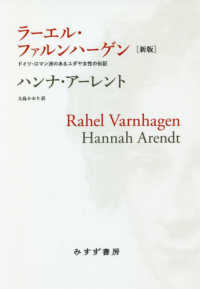- ホーム
- > 洋書
- > ドイツ書
- > Humanities, Arts & Music
- > Arts
- > theatre, ballett, film
Full Description
This edited collection is compiled from the first MENACA (Middle East, North African, and Central Asian) Dance and Music Symposium (Pomona College, March 13-16, 2023), and includes a wide variety of readings on Middle Eastern Dance and Music. The writers range from pioneers in the field of Middle Eastern dance and dance studies, from Barbara Sellers-Young, Karin van Nieuwkerk, and Anthony Shay to a range of newer voices. These authors come from dance, performance studies, theatre, and anthropology backgrounds and provide the reader with insights seen through a variety of lenses such as orientalism, colonialism and post-colonialism, nationalism, and Bourdieu's notion of capital to better understand the phenomenon of Middle Eastern dance and music in its many iterations. The collection gives equal coverage to the three major ethno-linguistic areas of the region: The Arab World, The Turkish World and the Iranian/Persianate World.
Contents
Introduction: Dance in the Middle East, North Africa and Central Asia.- Part 1: The Arab World.- Chapter 01: Belly Dance: Somatic Ways of Improvising Happiness.- Chapter 02: Dancing Bodies, Religion, and Gender in Egypt.- Chapter 03: Song in Najib Mahfuz' Palace Walk: Recreating and Appreciating the Diegetic "Soundtrack" of a Modern Egyptian Novel.- Chapter 04: Bourdieu's Thinking Tools Applied to Bellydance Research.- Chapter 05: Representations and paradoxes in the practice of belly dance in Egypt and Brazil.- Part 2: The Turkish World.- Chapter 06: Anatolian Folklore and the Construction of a New Turkish Identity.- Chapter 07: Halay: From Ritualistic Circle Dance to Political Act in Turkey.- Chapter 08: Motion and Transcendence in Euro-Turkic Context: the Alevi Semah.- Chapter 09: Standing in the Dâr: Shrinking the Body Towards the Vertical Axis in Alevi Rituals.- Part 3: The Iranian World.- Chapter 10: What Can Dance and Other Non-Dance Patterned Movement Systems Tell Us about Iranian Society?.- Chapter 11: The Quotidien and Cinematic Lives of Iranian Cabaret Dancers in Twentieth-Century Iran.- Chapter 12: Iranian Dancers Perform Despite Restrictions: Navigating a Sociopolitical Obstacle Course.- Chapter 13: Examining Dance as a Third Space in the Iranian Diaspora.- Chapter 14: Contemporizing Iranian Dance: The Importance of Using Pedagogy Rooted in Traditional Iranian Dance Aesthetics to Explore Current Themes.







